
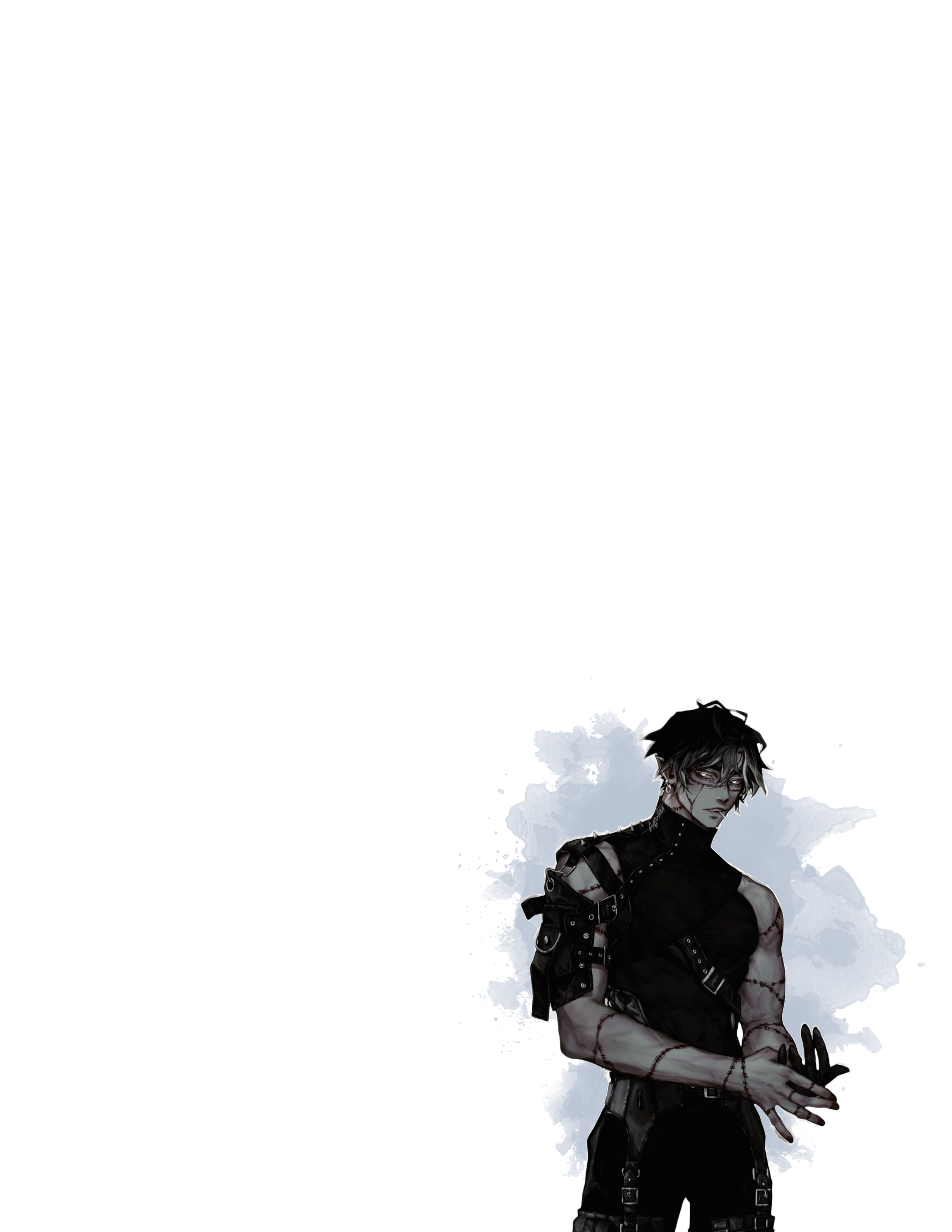
Chapter 1: Races
The Undying Collection introduces a new lineage option and three new races you can use in your campaign, alongside the races presented in the Player's Handbook and other official sourcebooks. These new races are:
Reanimated. Constructs that have been stitched together using body parts.
Boggart. A race of sentient Plant creatures that reside in the murky swamps.
Phantom. An Undead spirit that has roamed the Material Plane for centuries, teetering between here and the afterlife.
Symbiote. An Aberration whose unassuming appearance belies a deadly, powerful weapon.
Creating Your Character
At 1st level, you choose the race of your character from one of the official D&D sources or from a race in this collection. When you select a race, follow these rules during character creation.
Ability Score Increase
When determining your character's ability scores, unless stated otherwise, increase one score by 2 and increase a different score by 1, or increase three different scores by 1. Follow this rule regardless of the method you use to determine the scores, such as rolling or point buy. You can't raise any of your scores above 20.
Languages
Your character can speak, read, and write Common and one other language that you and your DM agree is appropriate for the character.
Creature Type
Every creature in D&D, including each player character, has a special tag in the rules that identifies the type of creature they are. Most player characters are of the Humanoid type. A race in this chapter tells you what your character's creature type is. These types don't have rules themselves, but some rules in the game affect creatures of certain types in different ways. For example, the cure wounds spell doesn't work on a Construct or an Undead.
Lineage
In The Undying Collection, the Reanimated is a lineage option available to you at character creation.
When you pick a lineage, you might have once been a member of another race, but you aren’t any longer. A character might choose this lineage during character creation. Or, events might unfold during your adventures that lead your character to replacing their race with this new lineage. Work with your DM to establish if you're amenable to such a development and how such stories unfold.
When choosing this lineage, follow these additional rules during character creation.
Ability Score Increase
If you are replacing your current race with a lineage, replace any Ability Score Increase you previously had with the rules stated earlier under Ability Score Increase.
Languages
If you are replacing your race with a lineage, you retain any languages you had and gain no new languages.
Reanimated
A reanimated is created by a special type of wizard called a stitcher. The stitcher will literally stitch together disparate body parts taken from corpses, and then imbue the newly created body with magic in order to bring it to life. While creating a reanimated is more time consuming and resource intensive than casting a spell, the resultant Construct is typically much more resilient compared to a mindless ghoul. A reanimated is also much smarter, and the stitcher can bestow upon its creation sentience should it wish to, or keep it mindlessly obedient. While many stitchers use reanimated as slave labour, a few allow their reanimated creations to pursue their own way in the world.
The race’s discoloured skin tones and visible stitches that criss-cross around its body are all clear signs of its own unnatural origins. A reanimated’s bodily appearance will often elicit disgust and fear, sometimes even violence. Villagers usually flee, and the occasional adventuring party will attack on sight, mistaking it for a flesh golem. As such, expecting to encounter a reanimated is extremely rare, driven to a solitary lifestyle by their own accursed nature.



Reanimated Traits
Your reanimated character has the following traits.
Creature Type. You are a Construct.
Age. A reanimated’s lifespan is indefinite, able to continue living as long as its own body holds.
Alignment. The procedure to create a reanimated can leave one’s mind and body altered in unpredictable ways. A creature that becomes a reanimated usually changes into a chaotic alignment if it wasn’t one before.
Size. You are Medium or Small. You choose the size when you gain this lineage.
Speed. Your walking speed is 30 feet.
Ancestral Legacy. If you replace a race with a reanimated, you can keep the following elements of that race: any skill proficiencies you gained from it and any climbing, flying, or swimming speed you gained from it.
If you don't keep any of those elements or you choose a reanimated at character creation, you gain proficiency in two skills of your choice.
Lightning Absorption. You have resistance to lightning damage. Additionally, when you take lightning damage, you can use your reaction to instead regain a number of hit points equal to the lightning damage you would have taken. You can use this trait a number of times equal to your proficiency bonus, and you regain all expended uses when you finish a long rest.
Living Machine. Your creator designed you to benefit from several spells that preserve life but that normally don't affect Constructs: cure wounds, healing word, mass cure wounds, mass healing word, and spare the dying.
Reconstructed Nature. You were created from a hodgepodge of different body parts, represented by the following benefits:
- You have advantage on saving throws against poison, and you have resistance against poison damage.
- You have advantage on death saving throws.
- You don't need to eat, drink, or breathe.
- You are immune to magical ageing effects.
Boggart
Nestled away in murky swamps and gloomy forests lies a race that considers it their home. A boggart is a sentient Plant, theorised by druids to have been created by a god of the Nature Domain to guard against potential threats that lurk in these shadowy environments. As such, the race has adapted to these dim, hostile conditions, evolving to spit debilitating projectiles and conjure weapons out of vines and thorns to protect itself and its surroundings.
Due to their appearance, natural habitat, and tendency to strike first, a boggart is occasionally mistaken for a more hostile Plant creature such as a shambling mound or tree blight. Skilled druids and rangers will be able to tell the difference between a boggart and other non-sentient Plant creatures, and a boggart usually become one itself to further its purpose to protect its own environment.
Boggart Traits
Your boggart character has the following traits.
Creature Type. You are a Plant.
Age. You are able to sustain yourself for around 150 years given proper sunlight, water, and nutrition.
Alignment. A boggart will likely lean toward a neutral alignment, focused on self-preservation first and foremost.
Size. You are Medium.
Speed. Your walking speed is 30 feet, and you have a swimming speed equal to your walking speed.
Amphibious. You breathe air and water.
Darkvision. You can see in dim light within 60 feet of you as if it were bright light and in darkness as if it were dim light. You discern colours in that darkness only as shades of grey.
Plant Camouflage. You have advantage on Dexterity (Stealth) checks made in any terrain with ample obscuring vegetation.
Plant Speech. You have the ability to communicate in a limited manner with Plants and vegetation. They can understand the meaning of your words, though you have no special ability to understand them in return.
Swampy Plumage. You know one of the following cantrips of your choice: acid spray, infestation, or thorn whip. Starting at 3rd level, you can cast one of the following spells of your choice: ensnaring strike, entangle, or ray of sickness. Starting at 5th level, you can also cast one of the following spells of your choice: blindness/deafness, spider climb (self only), or spike growth.
You choose a cantrip when you select this race, and you choose one of the proceeding spells upon reaching the stated level. If a spell requires a material component, you don’t require it to cast the spell. Once you cast the chosen 1st- or 2nd-level spell with this trait, you can't cast that spell with it again until you finish a long rest. You can also cast either of those spells using any spell slots you have of the appropriate level.
Intelligence, Wisdom, or Charisma is your spellcasting ability for these spells when you cast them with this trait (choose when you select this race).
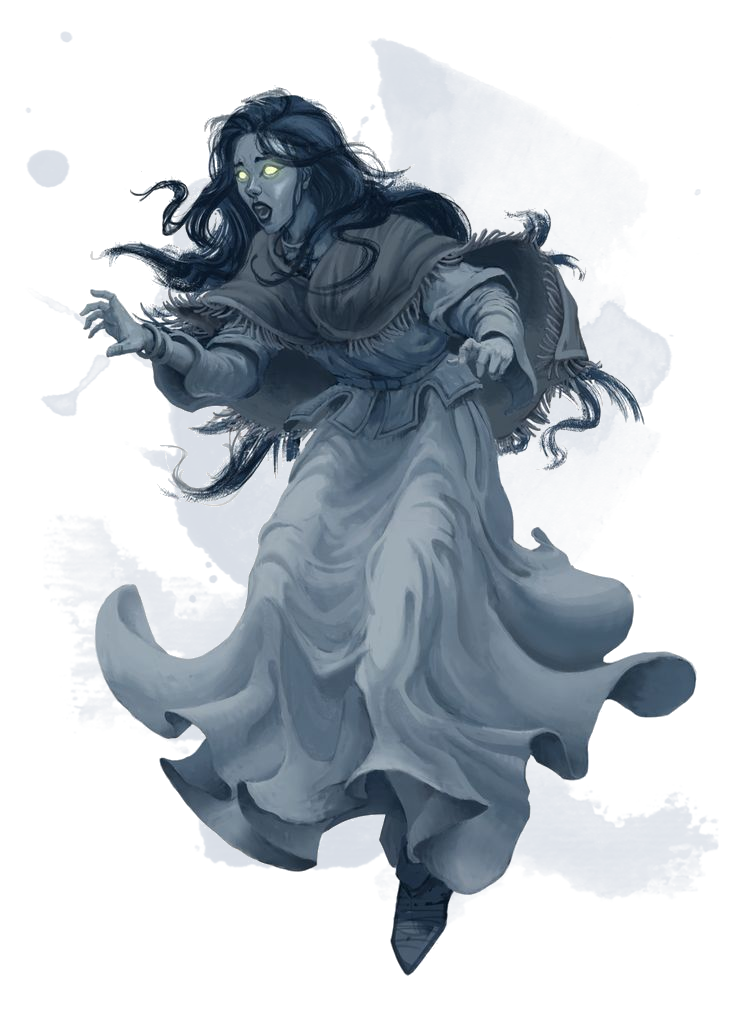
Phantom
A phantom is an Undead spirit that has roamed the Material Plane for centuries. This Undead spirit will typically start off as a ghost or revenant, having unfinished business that it seeks to resolve before passing on to the afterlife. However, it isn't uncommon for the spirit to never successfully resolve its lingering affairs.
As time passes, the spirit can easily forget the original reason behind not wanting to pass on. Many of these spirits become spectres. However, with sufficient time and sanity, some instead turn into phantoms, sitting in limbo between this life and the next.
This diminishing ability to exert itself in the physical world is a phantom's main characteristic. It can't possess living creatures like a ghost can, only a corpse. In its spirit form, it can't speak or affect physical objects, nor can it move into the Ethereal Plane. The fate of a phantom is one of slow moving entropy, where it can only wait until it fades into nonexistence.
Phantom Traits
Your phantom character has the following traits.
Creature Type. You are an Undead
Age. You are ageless, having already died centuries ago. Your soul lingers in the Material Plane for reasons unknown.
Alignment. A phantom’s alignment is dependent on the nature of its unfinished business. Strong enough to keep its presence in the Material Plane, a phantom is usually good or evil.
Size. You are Medium or Small. You choose the size when you select this race.
Speed. Your walking speed is 30 feet.
Darkvision. You can see in dim light within 60 feet of you as if it were bright light and in darkness as if it were dim light. You discern colours in that darkness only as shades of grey.
Ghostly Form. You are a wandering spirit, represented by the following benefits:
- You can move through solid matter that is no more than 5 feet thick, as well as through creatures and objects, as if they were difficult terrain, but you take 1d10 force damage if you end your turn inside solid matter, or a creature or object. You can’t move through a sheet of lead or metal.
- While walking, you can hover a couple inches off the ground. This does not allow you to cross gaps, causing you to fall unless you jump.
- You have resistance to nonmagical bludgeoning, piercing, and slashing damage. You are also immune to disease and being poisoned, and you have immunity to poison damage.
- You don't need to eat, drink, breathe, or sleep. You can finish a long rest in 4 hours by entering an inactive, motionless state, during which you retain consciousness.
In addition, you have a Strength score of 1 and automatically fail all Strength (Athletics), Dexterity (Acrobatics), and Dexterity (Sleight of Hand) checks. You also can’t speak or interact with creatures and objects, and you can’t use any class features.
Necrotic Immunity. You have immunity to necrotic damage.
Possession. As an action, you can possess a Humanoid corpse and bring it back to life. While possessing a body, you lose the Ghostly Form trait. You are also considered a Humanoid while possessing a body. You can choose to exit the body as an action.
The state of the body you possess depends on the number of hit points you have remaining. At full health, the body looks no different than it did in life. At half health, signs of greying and decomposition become visible. At close to 0 hit points, the body looks no different than a zombie. Exiting the body returns it to its decomposed state.
If you fail your death saving throws while possessing a body, you exit the body while remaining unconscious. During this state, your death saving throws are reset and you must repeat them again. If you succeed, you also regain 1 hit point.
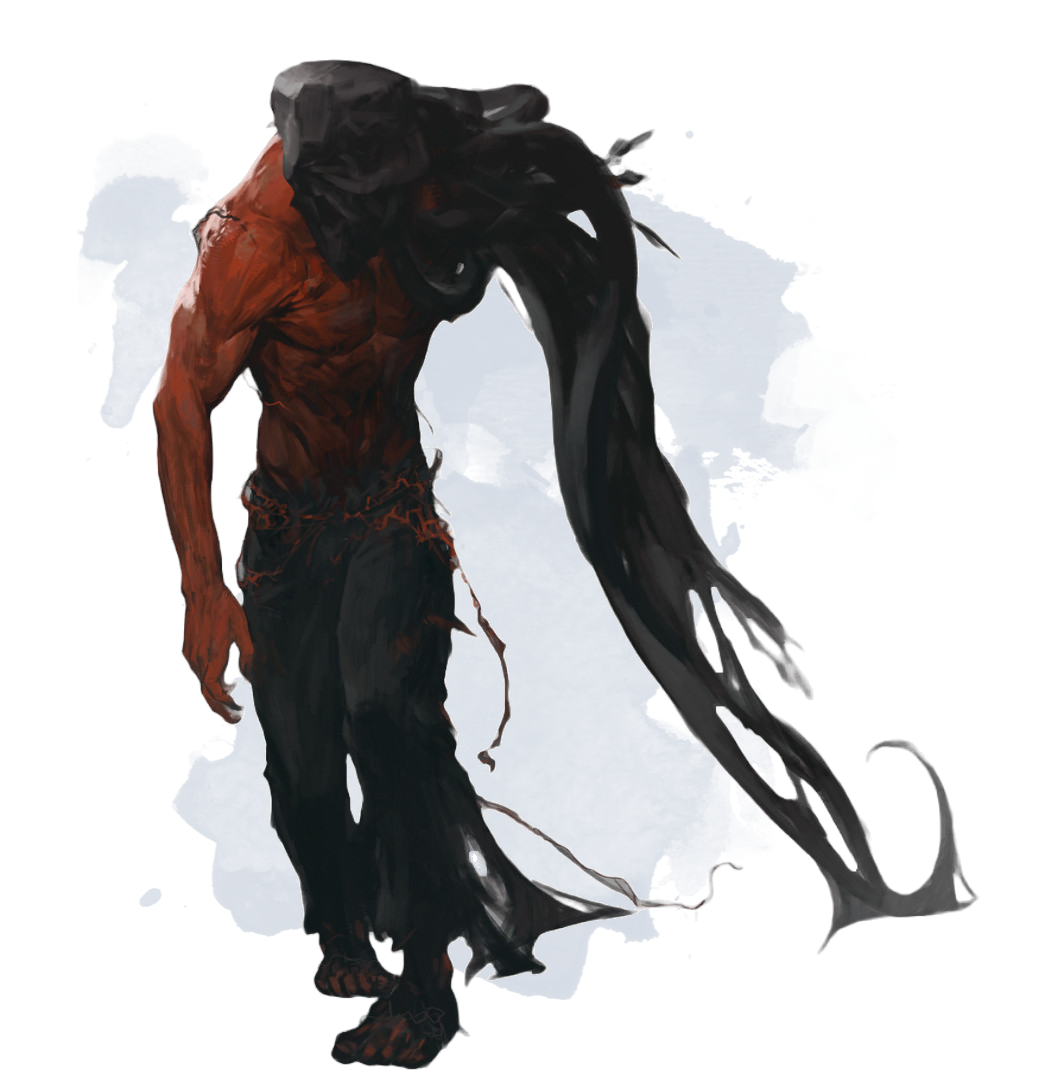
Symbiote
A symbiote is a race that hails from a far, distant Wildspace system. This race’s true form is a small, tadpole shaped creature that needs neither air nor food or water to survive. It is unknown if they have a homeworld, but colonies of symbiotes usually travel on gigantic celestial bodies, laying dormant until a suitable planet is found. These colonies superficially resemble asteroids at first glance, but on closer inspection, one would be able to see the furry texture of this rock and its unnatural blackness as it absorbs light. A symbiote colony can hold up to thousands of symbiotes.
When this colony nears a planet with sentient life, the rock will change course and hurl itself toward the planet. As it travels through the planet’s atmosphere, chunks of the rock will break apart in different directions, waking the symbiotes and scattering them across the planet’s surface. In this state, a symbiote can’t survive for very long, typically no more than a week. To stay alive, a symbiote must find one of the planet’s inhabitants and insert itself into the creature’s body through one of its orifices, travelling to its brain and devouring it from within. The creature must be sentient to sustain the symbiote and integrate itself with the host body.
While occupying a body, a symbiote will look and act no different than its host. The sole physical difference is the symbiote’s ability to alter the host body's limbs into a black material that appear like wispy, smoking tendrils, but are actually highly dense. A symbiote will usually use this weapon to catch victims unaware. Though a symbiote will usually adopt the host’s mannerisms and personality, it’s unknown whether this is simply rote imitation, or a survival tactic that hints at true intelligence. Reading its mind is impossible due to the symbiote’s anomalous nature.
Symbiote Traits
Your symbiote character has the following traits.
Creature Type. You are an Aberration.
Age. Your lifespan is the remaining lifespan of the creature you are inhabiting.
Alignment. You adopt the alignment of the
creature you are inhabiting. However, it is
unknown whether you truly adopt this
alignment or if it is simply mindless mimicry.
Size. Your size corresponds to the race
you have chosen with your Indiscernible
Appearance trait.
Speed. Your walking speed is 30 feet.
Aberrant Mind. Magic can't read your thoughts or put you to sleep.
Indiscernible Appearance. Upon selecting this race, you pick another Humanoid or Fey race, adopting its physical appearance. You don’t gain any traits from that race, but you are physically indistinguishable from another member of the same race.
Malignant Limb. You are able to transform your limbs into a dense, shadowy weapon, which you can use to make unarmed strikes. When you hit with it, the strike deals 1d6 + your Strength modifier bludgeoning damage, instead of the bludgeoning damage normal for an unarmed strike.
A creature that sees you attack in this way immediately knows you are not of the race you have chosen from your Indiscernible Appearance trait.
Mind Hopping. When you reduce a Humanoid’s hit points to 0 with your Malignant Limb, you can use a bonus action to transfer your brain to that creature, adopting its physical appearance and having it become the race that uses your Indiscernible Appearance trait. The previous body you inhabited then becomes headless.
Starting at 5th level, you also gain access to all information that the Humanoid would freely share with a casual acquaintance. Such information includes general details on its background and personal life, but doesn't include secrets. The information is enough that you can pass yourself off as the person by drawing on its memories.
Once you use this trait, you can't do so again until you finish a long rest.
Chapter 2: Subclass Options
New subclass options are available for you to use in your campaigns in this chapter. These additional options are designed to work with the rules provided in the Player's Handbook, Dungeon Master's Guide, and Tasha's Cauldron of Everything.
If you are a Dungeon Master, you can choose which options from this chapter your players can use in your campaign. You can also modify or even replace certain features listed here if you believe a feature isn't balanced or isn't thematically relevant. If there is any ambiguity regarding a subclass feature, the Dungeon Master has the foremost say on how it would be addressed.
The Subclass Options table lists the subclasses included in this collection. The following pages in this chapter will illustrate each of them in more detail.
Subclass Options
| Class | Subclasses |
|---|---|
| Artificer | Occultist |
| Barbarian | Path of the Damned |
| Bard | College of Sorrows |
| Cleric | Undead Domain |
| Druid | Circle of Death |
| Fighter | Fanatic |
| Monk | Way of Immortality |
| Paladin | Oath of Martyrdom |
| Ranger | Ferryman |
| Rogue | Reaper |
| Sorcerer | Ancestral Soul |
| Warlock | Puppeteer |
| Wizard | Dread Magic |
Artificer: Occultist
An Occultist is an artificer with a fascination for the undead and the afterlife. They may hold long stakeouts in graveyards and haunted sightings, or explore the ruins of an ancient tomb or burial site in order to learn more about the spirits of the afterlife. An adept Occultist is able to capture these spirits for use in their own inventions, and even commune with them.
Tools of the Trade
3rd-level Occultist feature
You gain proficiency with glassblower’s tools. If you already have this tool proficiency, you gain proficiency with one other type of artisan's tools of your choice.
Occultist Spells
3rd-level Occultist feature
You always have certain spells prepared after you reach particular levels in this class, as shown in the Occultist Spells table. These spells count as artificer spells for you, but they don't count against the number of artificer spells you prepare.
Occultist Spells
| Artificer Level | Spell |
|---|---|
| 3rd | cause fear, silent image |
| 5th | darkness, silence |
| 9th | fear, speak with dead |
| 13th | phantasmal killer, shadow of moil |
| 17th | contact other plane, danse macabre |
Spirit Catcher
3rd-level Occultist feature
Your study into the supernatural has culminated in a unique magic item that allows you to contain their essence. You can spend 1 hour using glassblower’s tools to create a spirit catcher, which you become immediately attuned to. You can use the spirit catcher as a spellcasting focus for your artificer spells. Once you create a spirit catcher, you can't do so again until you finish a long rest. You can have only one spirit catcher at a time.
As a reaction, when a creature you can see dies within 30 feet of you, you can use your spirit catcher and capture its lingering spirit, which is then stored inside the catcher. You can hold a maximum number of spirits equal to twice your proficiency bonus, and you can’t capture one while at your maximum.
You can use the captured spirits in the following ways:
- Once per day when you finish a short rest, you can expend a spirit and draw out its necrotic energy to recover expended spell slots. The spell slots can have a combined level that is equal to or less than half your proficiency bonus (rounded up).
- As a bonus action, you can expend a spirit and absorb its remaining life force. You gain a number of temporary hit points equal to your artificer level.
- As an action, you can expend a spirit by directing its baleful aura onto a hostile creature you can see within 30 feet of you. That creature must succeed on a Wisdom saving throw against your spell save DC or be frightened of you until the end of its next turn. When frightened in this way, the creature must take the Dash action and move away from you by the safest available route on each of its turns, unless there is nowhere to move.
If you are ever not attuned to the item, you create a new spirit catcher, or if you die, the current spirit catcher crumbles into glass shards and the spirits inside break free. A spirit can also break free if it is recalled as a result of a spell that raises it back to life (such as the raise dead spell).
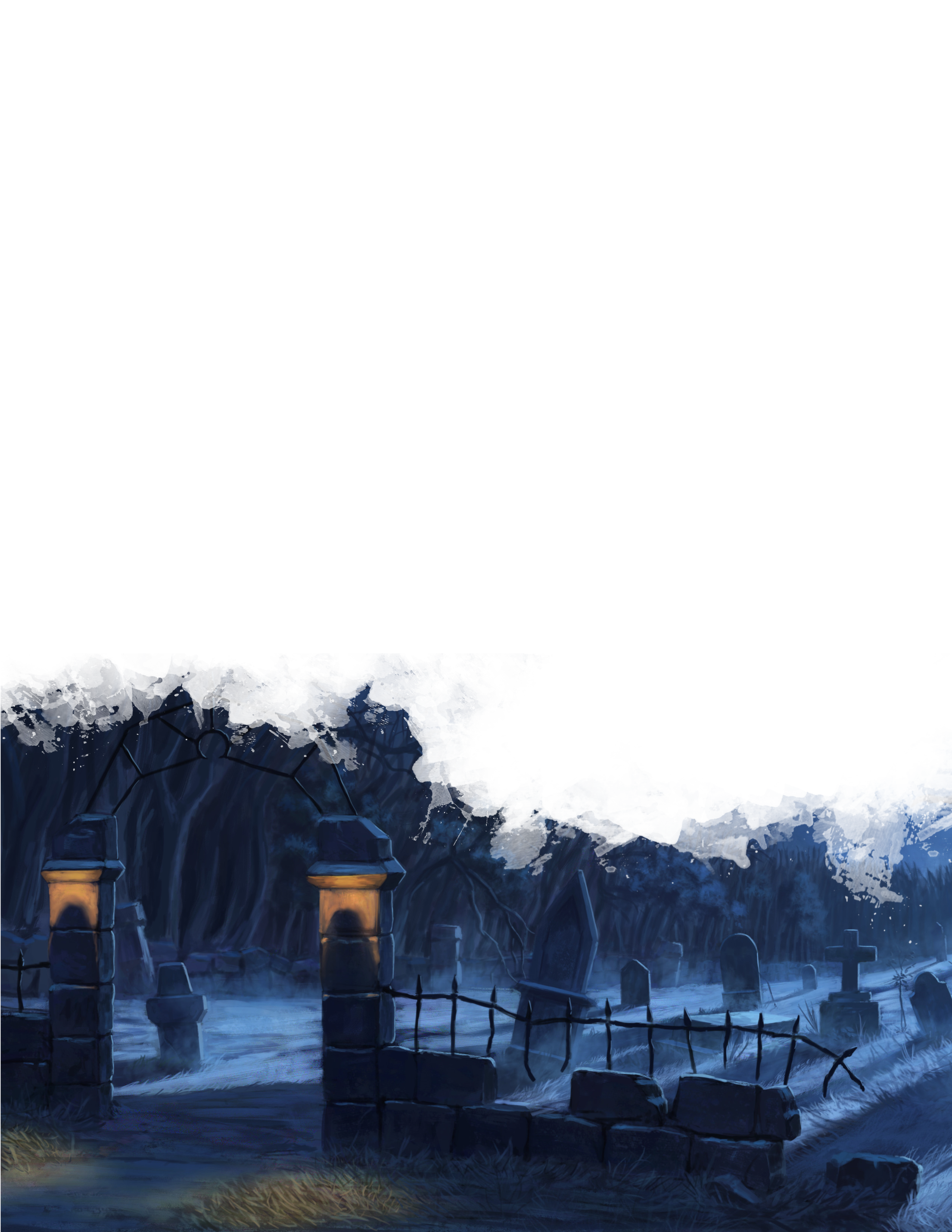
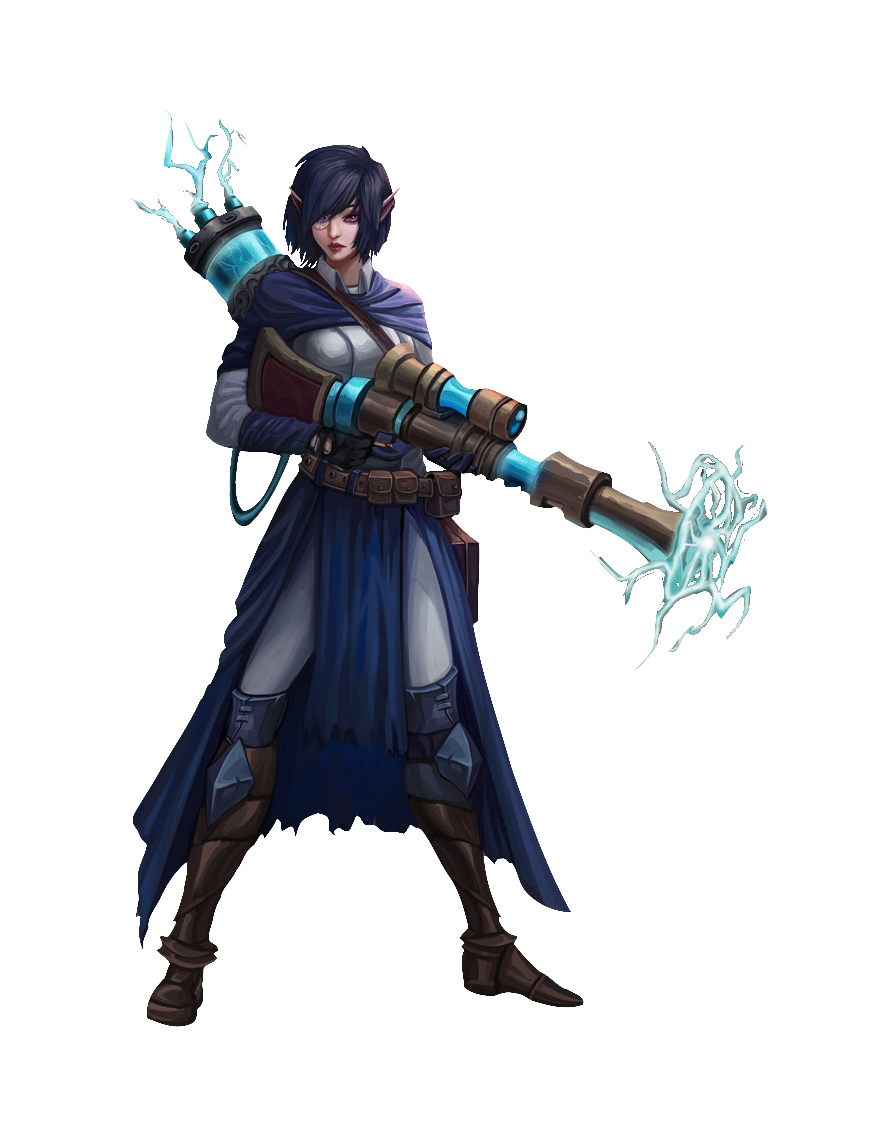
Necrotic Power
5th-level Occultist feature
You can use your captured spirits to increase your spell’s potency. When you cast a cantrip that deals damage, you can expend a spirit and choose to change the damage type to necrotic. You can also deal an extra 1d8 necrotic damage with the cantrip. When you reach 11th level in this class, the extra damage becomes 2d8.
Undead Commune
9th-level Occultist feature
You have spent so much time around the supernatural that you have an instinctive bond with them. As an action, you can expend one of your captured spirits to cast the summon undead spell without using any material components. When you do, you can only choose the Ghostly form, the spell doesn’t require concentration, and it lasts for up to 1 minute, or until you use this feature to cast the spell again.
In addition, you can expend one captured spirit and cast the speak with dead spell, targeting the spirit. As your captured spirits have travelled with you on your adventures, it will have learned new information and would be able to speculate about future events should it be inclined to do so.
Ghost Buster
15th-level Occultist feature
You have perfected the functionality of your spirit catcher. When you see an Undead creature within 30 feet of you that is a CR of 3 or lower, you can use an action to force the target to make a Constitution saving throw against your spell save DC. On a failed save, the target is reduced to 0 hit points and its spirit is instantly captured. At 17th level, you can use this feature on undead with a CR of 4 or lower.
In addition, you have resistance to necrotic damage and advantage on saving throws against being frightened. You can also cast the soul cage spell without expending a spell slot and without material components, provided you use glassblower’s tools as the spellcasting focus. Once you cast in this way, you can't do so again until you finish a long rest.
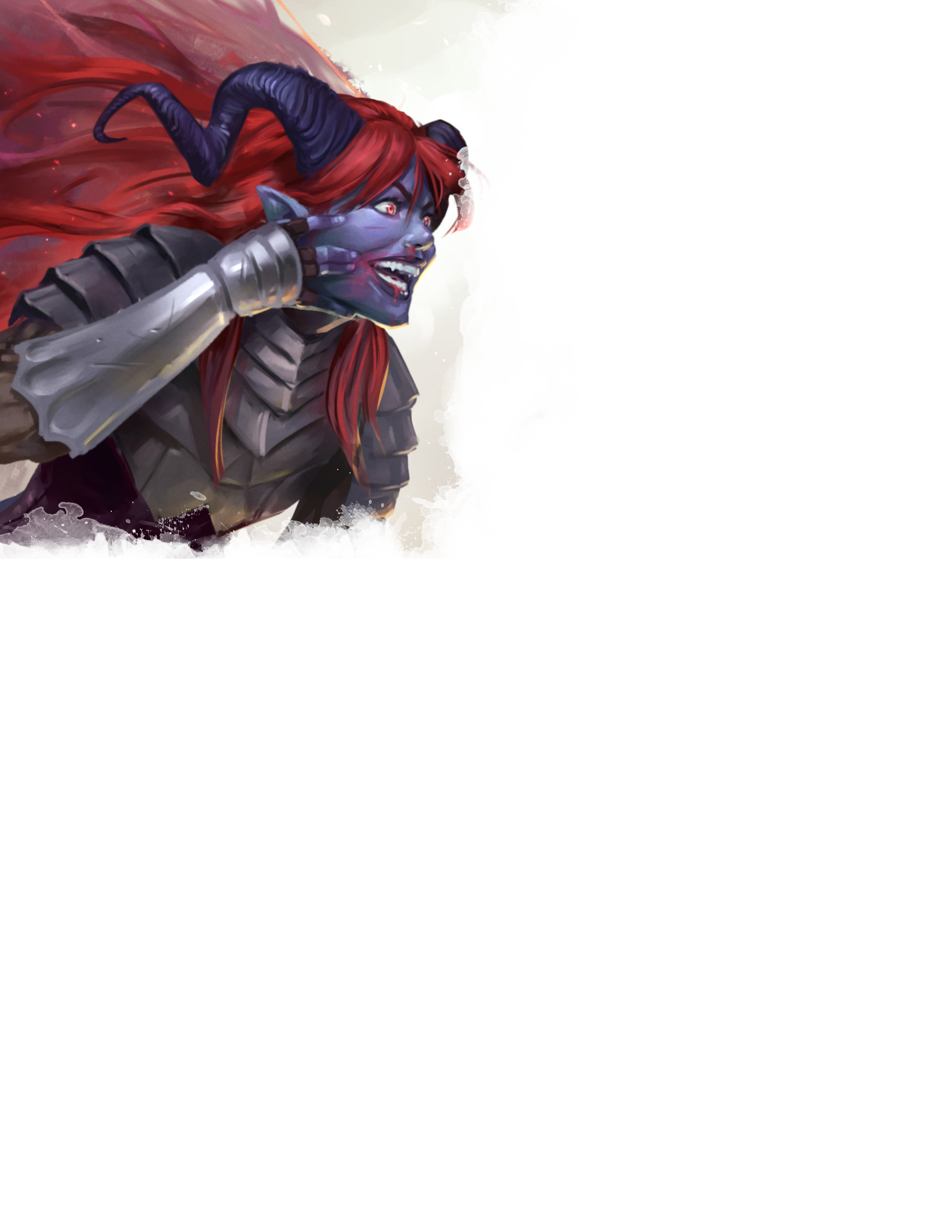
Barbarian: Path of the Damned
Your rage comes from the Nine Hells, the inhospitable plane where devils reside. Perhaps you have created a pact with one of its beings in hopes of serving them after death as a devil yourselves. Maybe you have always known that your anger and resentment came from a nefarious source. Or it may be the case that you hold a psychopathic disdain toward other Humanoids. Whatever its source, you know that your rage has damned you in both this life and the next.
Cursed Tongue
3rd-level Path of the Damned feature
Your fiendish affinity allows you to comprehend the language of the Nine Hells. You can speak, read and write Infernal.
Hellish Fury
3rd-level Path of the Damned feature
You feel the hellish source of your rage consume your soul. You gain resistance to fire damage while you are raging. When you hit a target with a melee weapon attack while raging, your bonus damage is determined by your proficiency bonus rather than the Rage Damage table.
In addition, you can use your reaction to cast the hellish rebuke spell without expending a spell slot (DC equal to 8 + your proficiency bonus + your Constitution modifier). You can cast this spell even while you’re raging. At 10th level in this class, you can cast this spell as a 3rd-level spell. You can use this reaction a number of times equal to your proficiency bonus, and you regain all expended uses when you finish a long rest.
When you enter your rage, your appearance changes to signify its hellish nature. You can choose these attributes or determine them by rolling on the Hell Brand table.
Hell Brand
d6 |
Brand |
|---|---|
| 1 | Ram horns grow on either side of your head and your feet change into hooves. |
| 2 | Red, skeletal wings magically sprout from your back, each one adorning a horn on its ends. They are useless for flying. |
| 3 | A crown of thorns forms from the hair atop your head, causing your scalp to bleed. |
| 4 | You grow a lion’s mane, the tail of a snake, and your body becomes covered in the fur of a bear. |
| 5 | Your arms become bony and malnourished, though you can still carry objects normally. |
| 6 | You grow a goat’s snout and your body becomes covered in brittle scales that peel off on contact. |
Devil's Sight
6th-level Path of the Damned feature
The nature of your rage affects even your senses. You gain darkvision out to a range of 60 feet, and magical darkness doesn't impede your darkvision.
Hell Companion
10th-level Path of the Damned feature
Your association with the Nine Hells has granted you a familiar. Once before the end of your next long rest, you can conduct a 1 hour ritual to summon an imp, which appears in an unoccupied space within 5 feet of you (see its stat block in the Monster Manual). The imp is friendly only to you, and obeys your commands.
In combat, the imp acts during your turn. It can move and use its reaction on its own, but the only action it takes is the Dodge action, unless you take a bonus action on your turn to command it to take another action. That action can be one in its stat block or some other action. If you are incapacitated, the imp can take any action of its choice, not just Dodge.
You can communicate telepathically with the imp as long as you are within 1 mile of it. You can also use an action to see and hear through its senses, and return to your own senses as an action; you are blinded and deafened to your surroundings while using the imp’s senses. While the imp is within 10 feet of you, you share its Magic Resistance trait.
The imp remains until it is reduced to 0 hit points, until you use this feature to summon the imp again, or until you die. Anything the imp was wearing or carrying is left behind when the imp vanishes.
Crafty Killer
14th-level Path of the Damned feature
You are not above employing dirty tactics to get the jump on your foes. When you first enter your rage, you can magically become invisible, along with any equipment you are wearing or carrying, until the start of your next turn.



Bard: College of Sorrows
Bards of the College of Sorrows spread about tales of tragedies, sadness, and betrayal. Such bards may tell eulogies of a figure that was dear to a community, or regale the spectacular downfall of a once revered leader. However, they don’t do so merely for cheap tears. Rather, those of this college believe these stories serve as reminders that life is not always about riding the highs, and that without the sorrows that come about every once in a while, people would not have the strength to push past such difficult times.
Traumatic Display
3rd-level College of Sorrows feature
You’re able to bring up a person’s repressed grief. You know the dissonant whispers spell, and it doesn’t count against the number of bard spells you know. You can cast this spell without using a spell slot a number of times equal to your Charisma modifier (minimum of once), and you regain all expended uses when you finish a long rest.
Whenever you start casting the spell, you can expend a use of Bardic Inspiration and modify the spell so that the creature rolls with disadvantage, or you roll a Bardic Inspiration die and add the number rolled to one damage roll of the spell (your choice).
Disheartened Exchange
3rd-level College of Sorrows feature
Your words can make others feel dispirited. When a creature adds one of your Bardic Inspiration dice to its ability check, attack roll, or saving throw and the roll fails, it can deal psychic damage equal to the number rolled on the die to any number of creatures of its choice within 5 feet of it.
Disarming Words
6th-level College of Sorrows feature
You can start a melancholic performance that can make all who hear it despondent. As an action, you can begin this performance which lasts for up to 1 minute (as if you’re concentrating on a spell). Each creature of your choice within 60 feet of you that can hear you must succeed on a Wisdom saving throw against your spell save DC or be charmed by you for the duration. While charmed in this way, the target has disadvantage on ability checks and attack rolls, and its speed is halved.
Once you use this action, you can't use it again until you finish a short or long rest, unless you expend a use of Bardic Inspiration to use it again.
Laborious Inspiration
14th-level College of Sorrows feature
Your tales tell the need to constantly fight through the troughs of life. When a creature holding one of your Bardic Inspiration dice is reduced to 0 hit points, it can use its reaction to roll the die, expending it and dropping to a number of hit points equal to 1 + the number rolled on the die instead. As part of the same reaction, the creature can move up to its speed and make one weapon attack, adding the number rolled to its attack roll.



Cleric: Undead Domain
Gods of the Undead Domain see mortals as an abomination; creatures whose gift of life is wasted on. Deities of this domain seek to unshackle mortals from the burdens that come with the survival of flesh and entice them with the promise of immortality. Gods of this domain have many powerful followers, from liches and dracoliches to necromancers and vampires.
The Undead Domain is an outlier amongst clerics. They are shunned by all other clerics for serving gods that actively look to exterminate life. However, like the deities they follow, clerics of this domain passionately believe undeath to be the ultimate form of life and are devoted to spreading them across the various realms. See the Undead Deities table for a list of some of the gods associated with this domain.
Undead Deities
| Example Deity | Pantheon |
|---|---|
| Chemosh | Dragonlance |
| Kiaransalee | Drow |
| Osiris | Egyptian |
| Velsharoon | Forgotten Realms |
Domain Spells
1st-level Undead Domain feature
You gain domain spells at the cleric levels listed in the Undead Domain Spells table. See the Divine Domain class feature for how domain spells work.
Undead Domain Spells
| Cleric Level | Spell |
|---|---|
| 1st | false life, inflict wounds |
| 3rd | blindness/deafness, ray of enfeeblement |
| 5th | animate dead, speak with dead |
| 7th | blight, shadow of moil |
| 9th | danse macabre, negative energy flood |
Necrotic Touch
1st-level Undead Domain feature
You can channel the power of undeath onto others. You learn the chill touch cantrip, which counts as a cleric cantrip for you and doesn't count against the number of cleric cantrips you know. When you cast this cantrip, its range is doubled.
Undead Emissary
1st-level Undead Domain feature
As a cleric for the Undead, the very same creatures hesitate to harm you. When an Undead creature targets you with an attack or harmful spell, you can use your reaction to force it to make a Wisdom saving throw against your spell save DC (a creature needn’t make this save if it includes you in an area spell, such as the fireball spell). On a failed save, the creature must choose another target or the attack or spell is wasted.
You can use this feature a number of times equal to your Wisdom modifier (minimum of once), and you regain all expended uses of it when you finish a long rest.
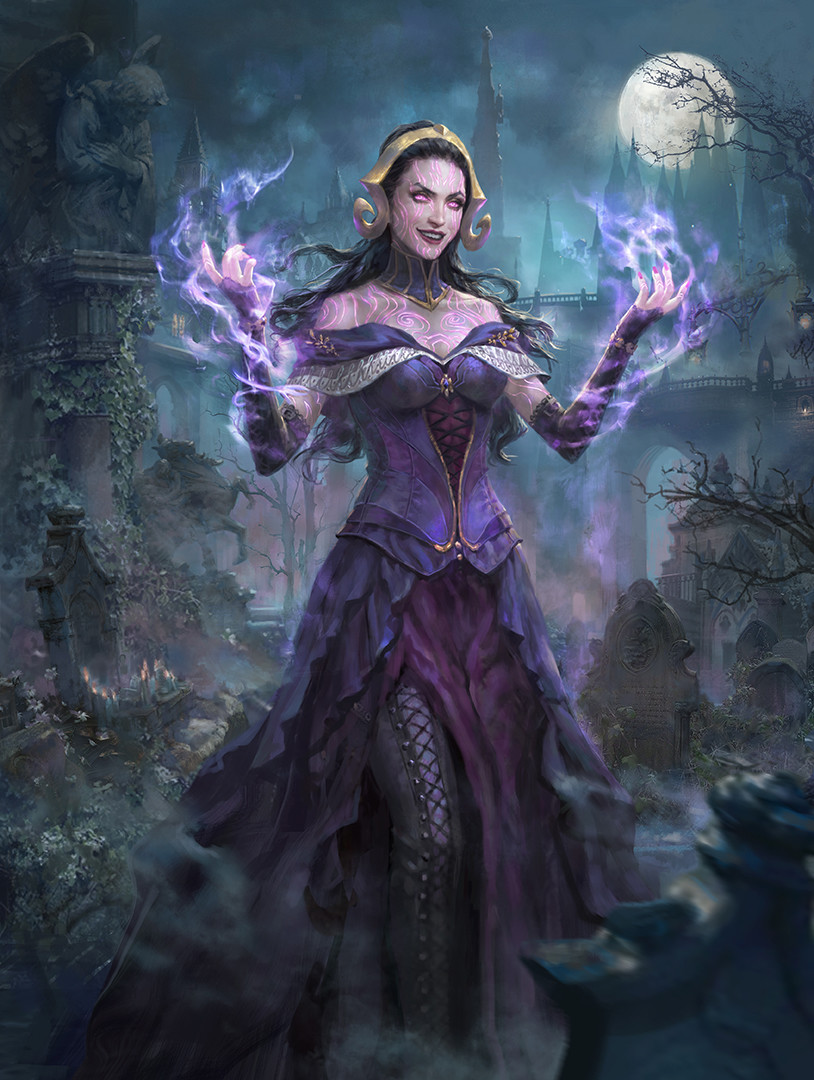

Channel Divinity: Indentured Undead
2nd-level Undead Domain feature
You can use your Channel Divinity to force Undead to serve you, instead of having them be turned.
When an Undead fails its Wisdom saving throw against your Turn Undead feature, you can choose to have it fall under your control for up to 1 minute (as if concentrating on a spell), instead of having it be turned. A creature can repeat this saving throw at the end of each of its turns and whenever it takes damage, ending the effect on a success.
As a bonus action, you can verbally command any creature controlled by you if the creature is within 30 feet of you (if you control multiple creatures, you can command any or all of them at the same time, issuing the same command to each one). You decide what action the creature will take and where it will move during its next turn. If you command a creature to make an attack, it can only make one attack roll, regardless of how many attacks it can normally make. If you issue no commands, the creature will not move and only take the Dodge action.
When you reach certain levels in this class, Undead of a certain CR or lower will automatically fail its saving throw against this Channel Divinity, as shown in the Destroy Undead table. This Channel Divinity option counts as a turned effect for the purposes of the Turn Immunity and Turn Resistance trait.
Channel Divinity: Undead Propagation
6th-level Undead Domain feature
You are devoted to spreading undead wherever you go. If a Beast or Humanoid that is Small or Medium dies within 30 feet of you, you can use your reaction to show your holy symbol and animate it. The corpse stands up and becomes an Undead, using the Undead Spirit stat block from the summon undead spell, as if cast at a 3rd-level. You choose the creature’s form: Ghostly, Putrid, or Skeletal, which determines certain traits in its stat block. You can expend an additional use of your Channel Divinity to add an additional level to the Undead Spirit’s stat block.
The Undead Spirit shares your initiative count, but it takes its turn immediately after yours. It obeys your verbal commands (no action required by you). If you don't issue any, it takes the Dodge action and uses its move to avoid danger.
The corpse remains animate for 1 minute, until it reaches 0 hit points, or until you use this Channel Divinity option again.
Potent Spellcasting
8th-level Undead Domain feature
You add your Wisdom modifier to the damage you deal with any cleric cantrip.
Undead Nature
17th-level Undead Domain feature
Serving your domain’s deity for so long has bestowed you with the following benefits:
- You don't need to eat, drink, sleep, or breathe.
- You are immune to disease and the poisoned condition.
- You gain immunity to necrotic damage and poison damage, and resistance to nonmagical bludgeoning, piercing, and slashing damage.
- You have a flying speed equal to your walking speed and can hover. You can move through creatures and objects as if they were difficult terrain, but you take 1d10 force damage if you end your turn inside a creature or an object.
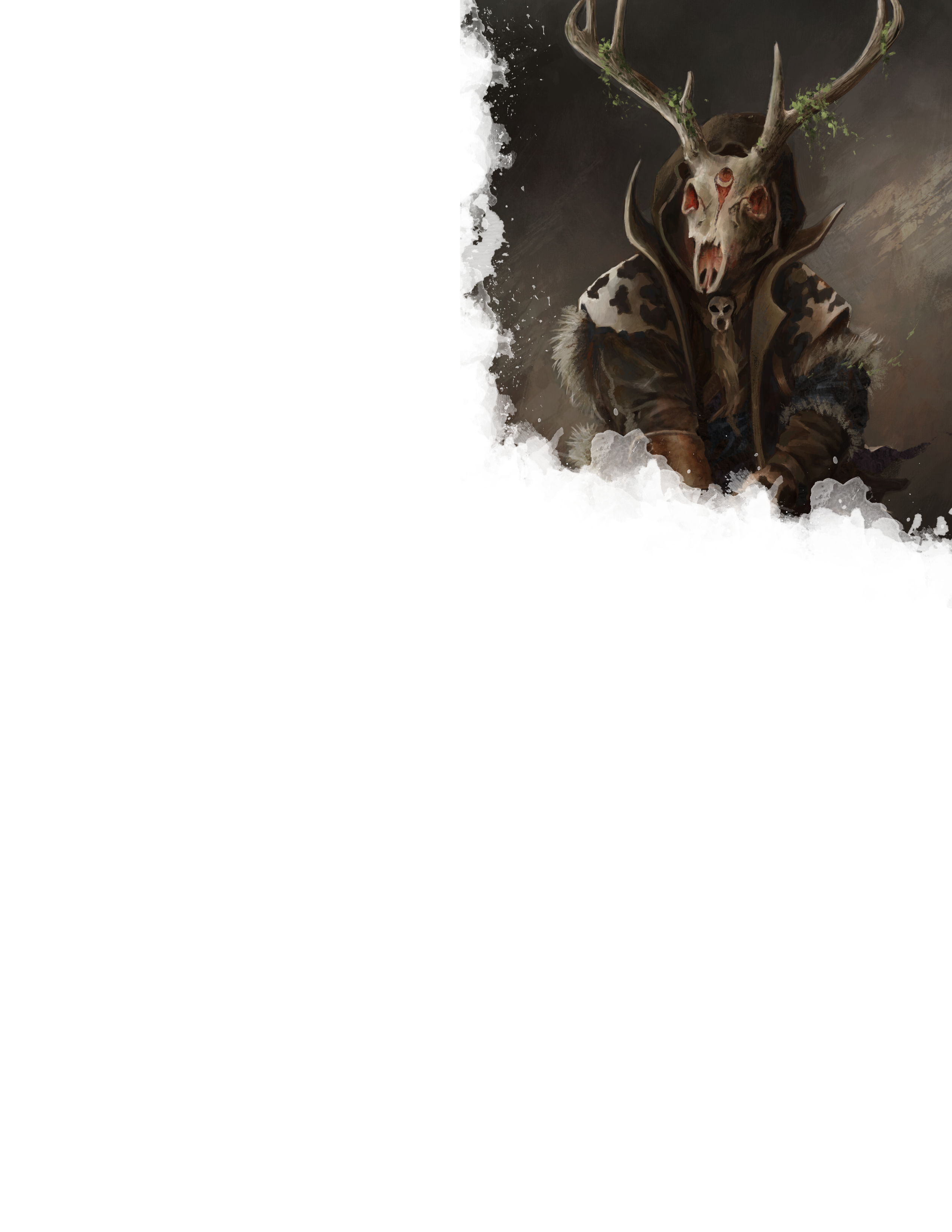
Druid: Circle of Death
Druids of the Circle of Death acknowledge and embrace death as a part of the natural cycle of life. These druids know that all mortal life must end eventually, and that attempting to prolong one’s life stifles the symbolic order of the Material Plane. Old life must always die in order to make way for the new to prevent stagnation and ensure all life can evolve and thrive.
Circle Spells
2nd-level Circle of Death feature
Your status as a bringer of death has granted you the ability to cast certain spells. You learn the chill touch cantrip. You also gain access to additional spells when you reach certain levels in this class, as shown on the Circle of Death spells table.
Once you gain access to one of these spells, you always have it prepared, and it doesn't count against the number of spells you can prepare each day. If you gain access to a spell that doesn't appear on the druid spell list, the spell is nonetheless a druid spell for you.
Circle of Death Spells
| Druid Level | Spell |
|---|---|
| 2nd | inflict wounds, ray of sickness |
| 3rd | darkness, ray of enfeeblement |
| 5th | phantom steed, vampiric touch |
| 7th | blight, vitriolic sphere |
| 9th | enervation, negative energy flood |
Shape of Death
2nd-level Circle of Death feature
You can draw upon your connection to death to prepare for the reaping of souls. As a bonus action, you can expend one use of your Wild Shape feature to take on this deathly persona, rather than assuming a beast form. While this feature is active, you gain the following benefits:
- When you activate this form, and as a bonus action on your subsequent turns while it lasts, you can choose one creature you can see within 30 feet of you and curse it with the mark of death for up to 1 minute (as if concentrating on a spell). Once on each of your turns, while the target is cursed, you can add an extra 1d6 damage to the damage roll of one attack or spell you make. This extra damage is necrotic damage. If you use a bonus action to mark a new creature, the current creature is no longer marked.
- When you deal necrotic damage, you can reroll any roll of 1 on the damage dice, and you must use the new roll.
- You can replace the damage type of your weapon attacks with necrotic damage.
These benefits last for 10 minutes. It ends early if you dismiss it (no action required), you die, or you use this feature again.
Decaying Deflection
6th-level Circle of Death feature
You can channel the energy from being harmed back at the attacker. When you are hit by an attack roll, you can use your reaction to force the attacker to make a Constitution saving throw against your spell save DC. On a failed save, the attacker takes necrotic damage equal to half the damage you were dealt.
You can use this feature a number of times equal to your proficiency bonus, and you regain all expended uses of it when you finish a long rest.
Power of Death
10th-level Circle of Death feature
Your proximity with death has given you a measure of protection from it. You gain resistance to necrotic damage.
If you are transformed using your Shape of Death, you become immune to necrotic damage. You are also able to add your Wisdom modifier to one damage roll of any necromancy spell you cast, and when you curse a creature, the extra damage becomes a 1d8.
Siphon Essence
14th-level Circle of Death feature
You can absorb the life force of creatures around you. Once during your turn, when you make an attack or cast a spell that deals necrotic damage, you can choose one target of the attack or spell within 30 feet of you. You regain a number of hit points equal to half the damage dealt.
You can use this feature a number of times equal to your Wisdom modifier (minimum of once), and you regain all expended uses of it when you finish a long rest.
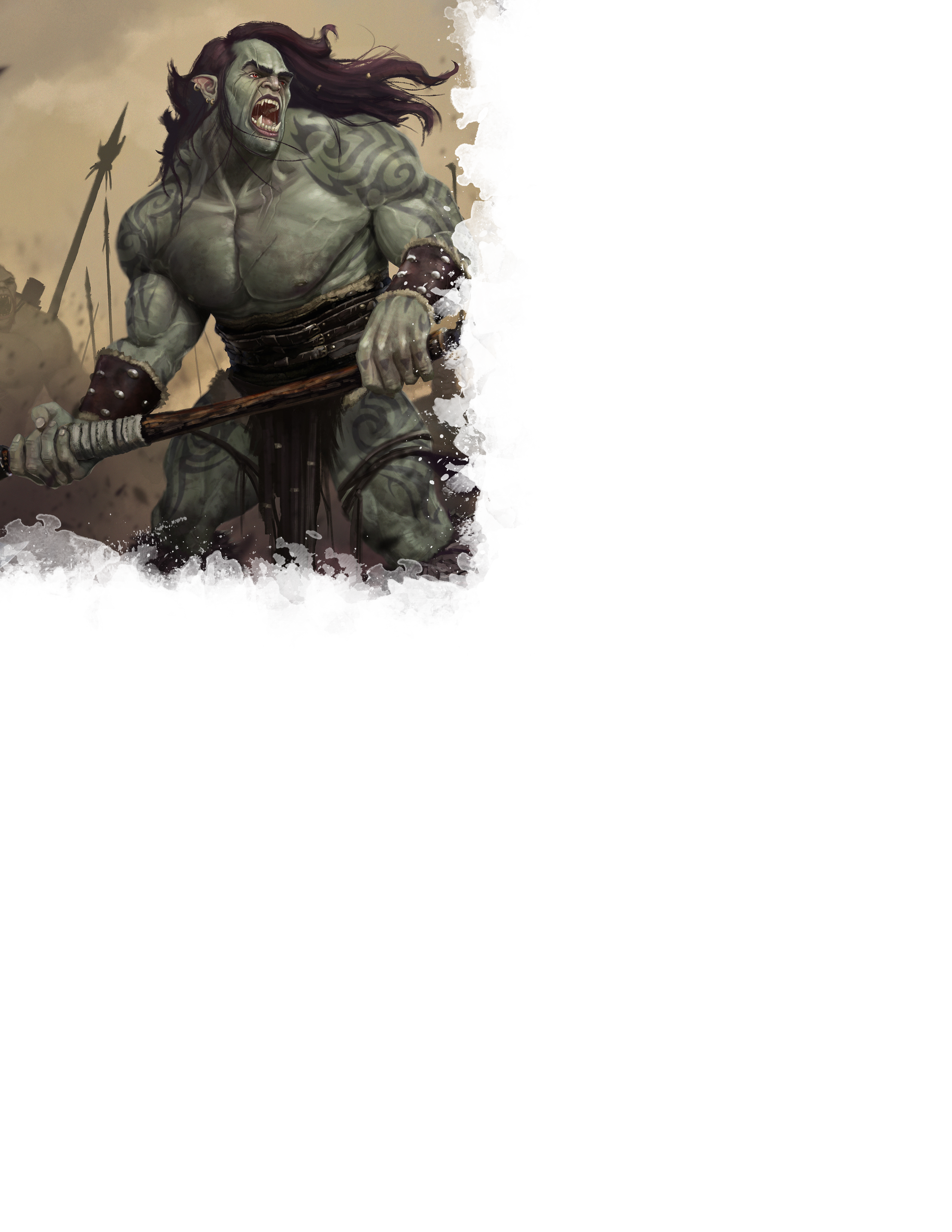
Fighter: Fanatic
The Fanatic wishes nothing more than to take part in glorious battle. The only thing that matters to them is the adrenaline that comes from an awesome fight, surrounded shoulder-to-shoulder with other ferocious adversaries. Both their mind and body have been honed for the thrill of battle, and are at their fiercest when backed into a corner or on the verge of death. To them, the battlefield is the only world that matters.
Fervid Strikes
3rd-level Fanatic feature
You thrive when pushed to the absolute limit of your physical endurance. When you are at a quarter of your maximum hit points or lower, you can make your weapon attack rolls with advantage.
Brutal Blow
3rd-level Fanatic feature
The power of your strikes are vicious. Once during each of your turns when you hit with an attack roll, you can deal extra damage to the target equal to your proficiency bonus
Physical Might
3rd-level Fanatic feature
Your body has been honed for the rigors of the battlefield. When you make a Strength (Athletics) check, you can treat a d20 roll of 7 or lower as an 8.
Unrelenting Endurance
7th-level Fanatic feature
You are not easily downed. When you are reduced to 0 hit points but not killed outright, you can use a reaction to drop to 1d10 + your fighter level hit points instead. You can't use this feature if the attack is a critical hit.
Once you use this feature, you can't do so again until you finish a long rest.
Multiattack
10th-level Fanatic feature
You are able to strike down against multiple enemies at once in the heat of battle. Once on your turn, when you take the Attack action, you can replace one of your attacks with one of the following features below:
Volley. You make a ranged attack against any number of creatures within 10 feet of a point you can see within your weapon's range. You must have ammunition for each target, as normal, and you make a separate attack roll for each target.
Whirlwind Attack. You make a melee attack against any number of creatures within 5 feet of you, with a separate attack roll for each target.
You can attack in this way a number of times equal to your Constitution modifier (minimum of once), and you regain all expended uses of it when you finish a long rest.
Indomitable Body
15th-level Fanatic feature
You shrug off injuries with ease. When you use your Indomitable feature to reroll a saving throw that has you take only half damage on a success, you instead take no damage if you succeed on the saving throw, and only half damage if you fail.
Fanatical Swing
18th-level Fanatic feature
Your attacks defy logic, carried through sheer force of will. When you hit a creature with a weapon attack, you can use a bonus action to have that attack ignore the creature's resistance and immunities.
In addition, you don’t automatically fail your attack roll when you roll a 1 on the d20; you instead add your attack roll modifier as normal.
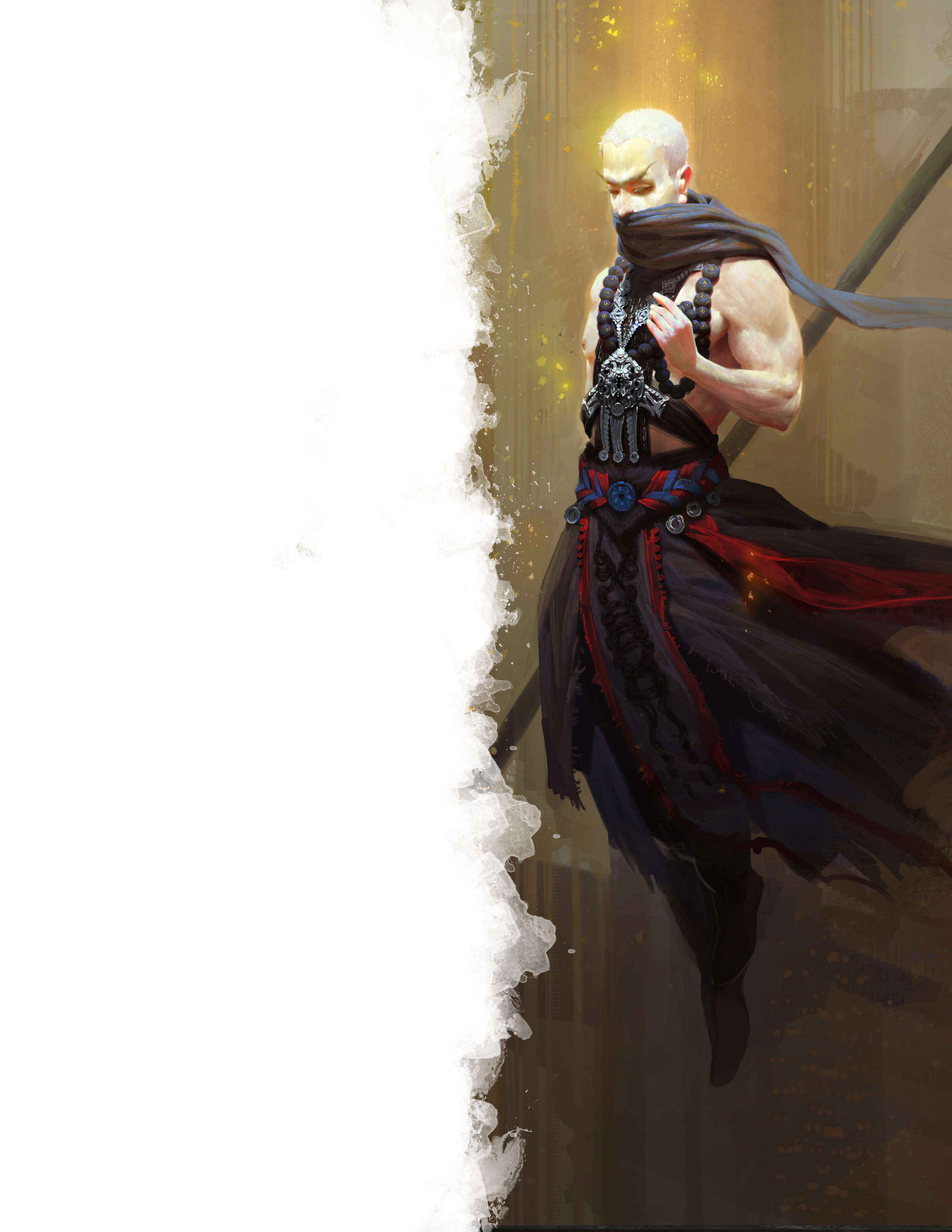
Monk: Way of Immortality
Monks of the Way of Immortality are devoted to the concept of eternal life. They use their ki to help extend their own natural lifespan well past what would normally be possible whilst still keeping their body in peak physical condition. Monks of this monastic tradition will spend their entire unending lives devoted to mastery of its techniques.
Recovering Strike
3rd-level Way of Immortality feature
You have learned techniques that allow you to quickly recover your body. Once on each of your turns, when you hit a creature with your unarmed strike or monk weapon, you can recover a number of hit points equal to half the damage dealt.
When you reach 11th level in this class, you can use this feature twice on your turn.
Ki Recovery
6th-level Way of Immortality feature
You are able to harness your ki’s energy to restore your life force. Whenever you spend ki points, you regain a number of hit points equal to the number of ki points spent.
Purity of Life
11th-level Way of Immortality feature
You can draw upon your ki to temporarily bolster your life force. Immediately after you take the Attack action on your turn, you can spend 2 ki points to cast false life as a bonus action.
You can spend additional ki points to cast false life as a higher-level spell. Each additional ki point you spend increases the spell's level by 1. The maximum number of ki points (2 plus any additional points) that you can spend on the spell equals a third of your monk level.
Everlasting Body
17th-level Way of Immortality feature
You have gained the ability to use your ki to extend your life. As an action, you can extend your lifespan by a number of years equal to the amount of ki points spent. Ki points expended in this way can’t be recovered until the end of a long rest.
In addition, you ignore the time limit of spells that have the sole effect of restoring you to life (but not undeath), such as the raise dead spell. Once you are brought back to life in this way, it can’t be replicated.
Untiring Physique
17th-level Way of Immortality feature
Your ki is able to passively heal your wounds. At the start of each of your turns, you regain hit points equal to 5 + your Wisdom modifier if you have no more than half of your hit points left. You don't gain this benefit if you have 0 hit points.
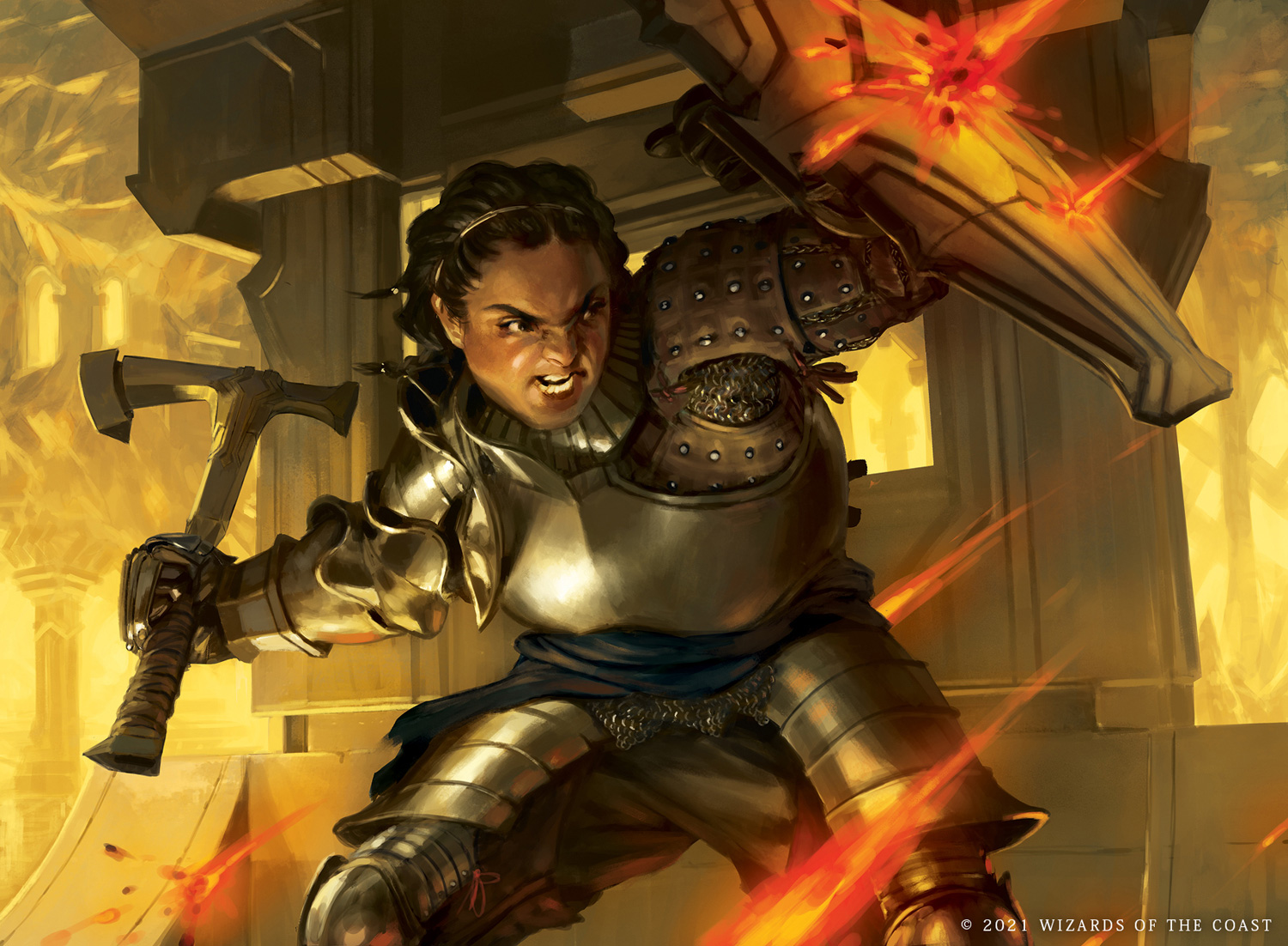

Paladin: Oath of Martyrdom
Paladins that take the Oath of Martyrdom lay down their bodies for the safety and wellbeing of others. Their own lives are nothing more than a means to this oath taken and as such, they won't hesitate to put their bodies on the line to fulfill their sole duty of the protection of others.
Tenets of Martyrdom
A paladin who assumes the Oath of Martyrdom is ready to lay down their own life for the sake of others.
Protect. Use your body as a shield for the weak. Protect those who cannot protect themselves.
Defend. You must use your life to defend these ideals. All life, strong or weak, deserves a chance to live.
Shelter. Your body is a haven for those who try to find respite. Take them under your wing until you are no longer physically able to.
Oath Spells
3rd-level Oath of Martyrdom feature
You gain oath spells at the paladin levels listed in the Oath of Martyrdom table. See the Sacred Oath class feature for how oath spells work.
Oath of Martyrdom Spells
| Paladin Level | Spell |
|---|---|
| 3rd | compelled duel, shield of faith |
| 5th | prayer of healing, warding bond |
| 9th | beacon of hope, life transference |
| 13th | aura of life, freedom of movement |
| 17th | cirlce of power, greater restoration |
Channel Divinity
3rd-level Oath of Martyrdom feature
You gain the following Channel Divinity options. See the Sacred Oath class feature for how Channel Divinity works.
Unquestioning Shield. As a reaction, when a creature you can see within 30 feet of you is hit by an attack roll, you can magically take that damage, instead of the creature taking it. The attack acts as if you were the intended target, transferring any effects that might accompany the damage. You can use this Channel Divinity even when you have already taken a reaction before the start of your next turn, but not on the same turn as another reaction.
Relentless Endurance. You're able to push yourself past your physical limits in order to protect your allies. When you are reduced to 0 hit points, you can use your Channel Divinity as a reaction and drop to 1 hit point instead. You can use this Channel Divinity even when you have already taken a reaction before the start of your next turn, but not on the same turn as another reaction.
Aura of the Defender
7th-level Oath of Martyrdom feature
You are able to leap into danger to save your allies at a moment’s notice. When an attacker you can see targets any creature of your choice within 10 feet of you other than yourself, it has disadvantage on the attack roll while you're not incapacitated. If the attack still hits, you can use your reaction to take half the damage from the creature. This doesn't transfer any other effects that might accompany the damage, and this damage can't be reduced in any way.
At 18th level, the range of this aura increases to 30 feet.
Steadfast Protector
15th-level Oath of Martyrdom feature
Your unwavering ideals to lay down your life for others has made you an untiring bulwark. You gain proficiency in Constitution saving throws. If you already have this proficiency, you instead gain proficiency in Strength or Intelligence saving throws (your choice).
In addition, when you roll initiative and have no uses of Channel Divinity remaining, you regain one use.
Martyr Exemplar
20th-level Oath of Martyrdom feature
You draw upon the martyrs of your faith to strengthen your powers. As a bonus action, you gain the following benefits for 1 minute:
- Your Aura of the Defender extends to 60 feet.
- You gain temporary hit points equal to half your hit point maximum.
- You get a special reaction that you can take once on every creature's turn, except your turn. You can only use this special reaction to take half damage on behalf of another creature using your Aura of the Defender, and you can't use it on the same turn as another reaction.
Once you use this bonus action, you can't use it again until you finish a long rest, unless you expend a 5th-level spell slot to use it again.
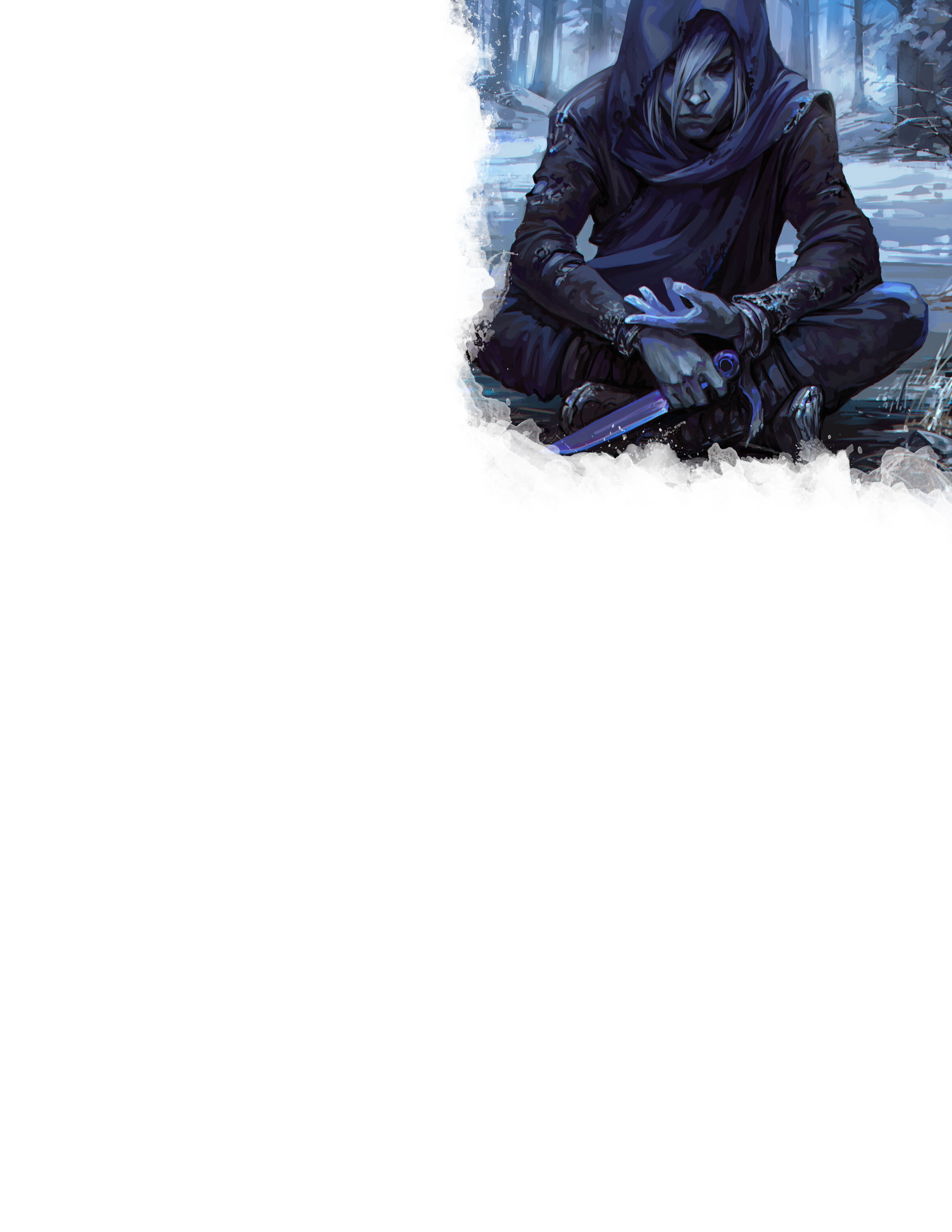
Ranger: Ferryman
A Ferryman is a ranger that seeks to protect the natural order of life and death. They utilise their natural talents of tracking and surviving in bleak environments to remove undead threats. A Ferryman’s motivations might vary; some seek out lost souls like revenants and specters to help them finish their business, others actively hunt those who purposefully violate and threaten the sacred cycle of life such as liches, evil necromancers and hateful spirits.
Ferryman Magic
3rd-level Ferryman feature
You learn the spare the dying cantrip if you don’t already know it. When you cast it, grass and other small flowers grow around the body as you rejuvenate the immediate area with life energy.
You also learn an additional spell of 1st-level or higher when you reach certain levels in this class, as shown in the Ferryman Spells table. Each spell counts as a ranger spell for you, but it doesn't count against the number of ranger spells you know.
Ferryman Spells
| Ranger Level | Spell |
|---|---|
| 3rd | bless |
| 5th | gentle repose |
| 9th | speak with dead |
| 13th | death ward |
| 17th | holy weapon |
Soul Cutter
3rd-level Ferryman feature
You’ve learned to sever soul from body in order to take down undead threats. When you hit a creature with a weapon attack, you can force it to make a Constitution saving throw. On a failed save, the creature takes an extra 1d6 psychic or radiant damage (your choice), and it takes this extra damage at the start of each of its turns. This effect lasts for 1 minute, and a creature can only be affected by one instance of this feature at a time. It ends early if you become incapacitated. The creature can also repeat the saving throw, ending the effect on a success.
You can use this feature a number of times equal to your proficiency bonus, and regain all expended uses when you finish a long rest.
Enhanced Life Force
3rd-level Ferryman feature
Your affinity with the life energy around you has bestowed upon you a stronger physique. Your hit point maximum increases by 3 and then increases by 1 whenever you gain a level in this class.
Unwavering Nerve
7th-level Ferryman feature
The unspeakable encounters you’ve had in your travels has given you an unbreakable resolve few others possess. You are immune to being frightened.
Fated Severance
11th-level Ferryman feature
Your ability to separate the soul from body has further improved. Once on your turn, when you hit a creature that is affected by your Soul Cutter feature with a weapon attack, you can forgo rolling damage dice and deal maximum damage (this includes damage from spells or effects that deal damage on a hit, such as the hunter’s mark spell). Additionally, all damage dealt becomes psychic or radiant damage (your choice) as the weapon or ammunition glows with ethereal energy and passes through the target.
Once you use this feature, you can’t do so again until you finish a long rest, unless you expend a spell slot of 3rd-level or higher to use it again.
Undying Soul
15th-level Ferryman feature
Being on the precipice between life and death has allowed you to control your life states to a limited degree. You only need to make 2 death saving throws instead of 3 in order to stabilize yourself.
In addition, when you are reduced to 0 hit points but not killed outright, you can choose to immediately regain a number of hit points equal to 1d10 + your ranger level. You can regain hit points in this way a number of times equal to your proficiency bonus, and you regain one expended use when you finish a long rest.


Rogue: Reaper
A Reaper is a rogue that is under the employ of a deity of death. When a creature is on death’s door, or if they have outlived their prescribed life in the threads of fate, these rogues will enact the will of their god to end their target’s life with extreme prejudice. As such, rogues of this archetype are primed for killing and nothing more.
Necrotic Scythe
3rd-level Reaper feature
Your role as the harbinger of death has granted you a special weapon you can summon to aid in your endeavours. As a bonus action, you can gather wisps of shadow to manifest a scythe in your free hand. This magic weapon is a martial melee weapon with which you are proficient in and has the finesse and reach properties. On a hit, it deals necrotic damage equal to 1d8 plus the ability modifier you used for the attack roll. You can't be disarmed of the weapon unless you are incapacitated, and you can make it disappear as a bonus action.
Once on each of your turns, when you make an attack with this weapon, you can target another creature within 5 feet of the original target that is also in range, making a separate attack roll for each one. On a hit, the weapon deals 1d4 necrotic damage to the second target (you don't add the ability modifier used for the attack roll to the second target). If your Sneak Attack applies to both creatures, you can choose to divide the Sneak Attack damage equally between them.
Wailing Exchange
3rd-level Reaper feature
You're able to interrogate the souls you reap. When a creature dies as a result of being hit by your Necrotic Scythe, you can use an action to ask its spirit one question, answering in a language it knew in life. It's under no obligation to be truthful, and it answers as concisely as possible. The spirit knows only what it knew in life, as determined by the DM. It lingers for up to 10 minutes in the space it was killed, after which it passes on.
Umbral Cloak
3rd-level Reaper feature
You are adept at evading creatures in the dark. While in darkness, you can use a bonus action to become invisible to any creature that relies on darkvision to see you in that darkness until the start of your next turn. You can use this bonus action a number of times equal to your proficiency bonus, and regain all expended uses when you finish a long rest.
You also gain darkvision out to a range of 60 feet. If you already have darkvision from your race, its range increases by 30 feet.
Soul Harvesting
9th-level Reaper feature
Harvesting souls is second nature to you. When a creature is reduced to 0 hit points as a result of being hit by your Necrotic Scythe, you can make one weapon attack with it as a bonus action. When you do, you can also target another creature within 5 feet of the original target that is also in range, making a separate attack roll for each one. The second target takes 1d4 necrotic damage on a hit (you don't add your ability modifier to the damage of the second target).
Unseeing Shroud
13th-level Reaper feature
You are able to make yourself disappear in a pinch. When you are damaged by an attack or spell, you can use your reaction to magically become invisible until the start of your next turn.
Once you use this feature, you can't do so again until you finish a long rest.
Life Ender
17th-level Reaper feature
You are able to tear apart the life essence of other creatures. Once during your turn, when you roll extra damage for your Sneak Attack, you can forgo rolling and deal maximum damage.
Once you use this feature, you can't do so again until you finish a long rest.



Sorcerer: Ancestral Soul
You have inherited your power from the spirits of your ancestors. Your ancestors, in one way or another, are closely tied to a source of magic, likely for generations. As an Ancestral Soul, the strong ties you foster with your forebears not only empower your own magic, but allow you to be aided by them directly by tapping into their wellspring of knowledge and wisdom.
How has your own bloodline cultivated this innate magical power? Was it through careful preservation of your family’s lineage? Did you enlist the help of a necromancer so you could commune with your forefathers? Consult the Ancestral Origins table for a possible origin of your power.
Ancestral Origin
d6 |
Origin |
|---|---|
| 1 | Your great ancestor was an archmage of great power and carefully enlisted traditions to preserve their magic bloodline. |
| 2 | Historically, your family has always had a strong connection to the spirits of the afterlife, allowing one to communicate with a passed family member. |
| 3 | Through rigorous meditation, you are able to commune with your ancestors. |
| 4 | You had a cleric teach you ways for communing with the afterlife, and have refined those techniques past what the faith finds acceptable. |
| 5 | Your ancestors have forged their name in your country’s history books, and their presence has manifested in you as magic. |
| 6 | You have actually received this boon recently through a fortuitous encounter with a celestial, a fey, or some other being deeply attuned to the spirits. |
Magic Heirloom
1st-level Ancestral Soul feature
As your magic is greatly tied to the connection you have with your ancestors, you possess an heirloom, a Tiny object passed down from generation to generation which you have with you at all times. While you are alive, the heirloom can’t be destroyed. You can use your Magic Heirloom as a spellcasting focus for your sorcerer spells. If you die and have no direct family members, the heirloom crumbles into dust.
Additionally, from 3rd level in this class, while the heirloom is on your person, you can regain a number of sorcery points at the end of a short rest equal to half your proficiency bonus. You still can’t have more sorcery points than shown on the table for your level, as normal, and you must finish a long rest before using this benefit again.
Ancient Wisdom
1st-level Ancestral Soul feature
Through communing with your ancestors, you are able to tap into their experiences. Whenever you finish a long rest, you can choose one skill or tool proficiency that you lack and gain it, as one of your ancestors shares its knowledge with you. You lose this proficiency when you use this feature to choose a different proficiency that you lack.
At 10th level in this class, you can choose up to two skills or tool proficiencies, and can change one or both of them at the end of a long rest.
Empowering Knowledge
6th-level Ancestral Soul feature
You tap into the depths of your forefathers’ knowledge to aid your allies. You can spend 1 sorcery point to use the Help action as a bonus action, and you can choose a creature within 30 feet of you that you can see to benefit from this action, rather than within 5 feet of you, as long as the target can both see and hear you.
Concentrated Mana
14th-level Ancestral Soul feature
Your magical bloodline is so refined that it requires less magical energy for you to manipulate spells. When you use your Font of Magic feature, you can do one of the following:
- You regain one extra sorcery point when expending a spell slot.
- You spend one less sorcery point to create a spell slot of the chosen level.
You can use each benefit once, and you regain the ability to do so when you finish a long rest.
Magical Overload
18th-level Ancestral Soul feature
You draw upon the collective magic of your ancestors to empower your spells. Whenever you cast a spell that deals damage and you use a Metamagic Option on that spell, you add a number of d8 to one damage roll of the spell equal to the number of sorcery points used.



Warlock: Puppeteer
You have signed away your free will in a pact with a being of great intellect and control. They might be an elder brain, the horrifying greater form of a star spawn emissary, or some other Elder Evil or hivemind. Whoever or whatever your patron, you are now completely under their control, your will completely subsumed by it. You may feel as if your actions are still your own and respond to things like your old self, but each decision you make is that of your patron’s to further its own goals. You no longer exist.
Expanded Spell List
1st-level Puppeteer feature
The Puppeteer lets you choose from an expanded list of spells when you learn a warlock spell. The following spells are added to the warlock spell list for you.
Puppeteer Expanded Spells
| Spell Level | Spells |
|---|---|
| 1st | command, dissonant whispers |
| 2nd | detect thoughts, tasha’s mind whip |
| 3rd | sending, nondetection |
| 4th | divination, phantasmal killer |
| 5th | modify memory, rary’s telepathic bond |
Subtle Nudge
1st-level Puppeteer feature
Your patron is able to discreetly interfere in your affairs to further its own agenda. When you make an ability check, attack roll, or saving throw, you can choose to add your Charisma modifier to the roll.
Once you use this feature, you can't use it again until you finish a long rest.
Aberrant Shield
1st-level Puppeteer feature
Your patron’s vast intellect shields you from prying minds. Magic can't read your thoughts or put you to sleep.
Implant Trigger
6th-level Puppeteer feature
You’re able to discreetly manipulate others. You learn the suggestion spell, and it doesn't count against the number of spells you know. Additionally, when you choose a target that is incapacitated, you can use a bonus action to make it automatically fail its saving throw against the spell. You must finish a long rest before you can use this bonus action again.
Ego Fortress
10th-level Puppeteer feature
Your patron’s vast intellect makes it difficult for others to penetrate your psyche. You gain advantage on Intelligence, Wisdom, and Charisma saving throws against spells, as long as you aren’t charmed or frightened.
Great Machinations
14th-level Puppeteer feature
Your patron is able to observe and influence other people through you. As an action, you can choose one Humanoid you can see within 30 feet of you to make an Intelligence saving throw against your spell save DC. On a failed save, you plant a sliver of your consciousness inside the target’s mind, which it is unaware of, that lasts for up to 30 days or until you harmlessly remove it as an action. You can have only one Humanoid under the effect of this feature at a time. Once a creature fails its saving throw against this feature, you can’t use it again until you finish a long rest.
Once a day, while this sliver exists, you can do one of the following as an action:
- You can see and hear through the target’s senses for up to 1 minute, ending early if you dismiss it (no action required). You gain the benefits of any special senses possessed by the creature, though you are blinded and deafened to your own surroundings.
- You can read the target’s surface thoughts for up to 1 minute. If you choose to probe the target’s mind, it must make an Intelligence saving throw. If it fails, you gain insight into its reasoning (if any), its emotional state, and something that looms large in its mind (such as something it worries over, loves, or hates). If it succeeds, you stop reading its mind.
- You can take limited control of the target for up to 1 hour, ending the control early as a bonus action. While you are controlling the target, your own body is unconscious. You gain access to enough information that you can pass yourself off as the person by drawing on its memories. You retain your Intelligence, Wisdom, and Charisma scores, as well as any existing proficiencies, but otherwise adopt the target's statistics. If you enact an action that would be directly harmful to the target, the effect instantly ends. When your control ends, the sliver disappears and the target knows it was being controlled by you.
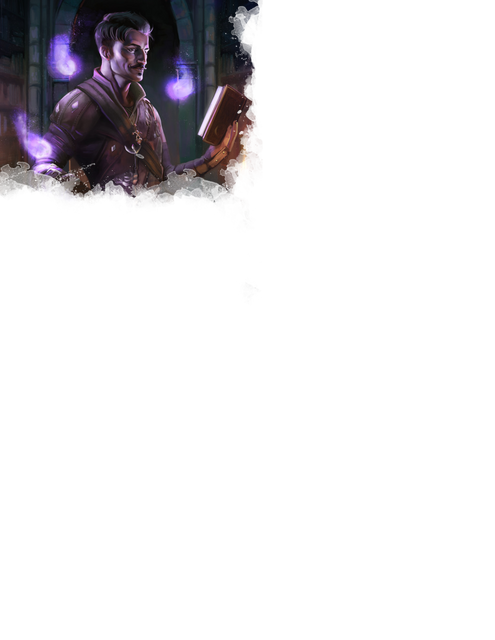
Wizard: Dread
Wizards that practice Dread Magic devote themselves to understanding one of the most primal emotions humanoids possess: fear. Through the study of fear, wizards of this arcane tradition are able to lace their spells with insidious energy to unsettle their adversaries. A battle is first decided by a war of the minds, and assaulting one’s mind with fear strong enough to immobilize the body will have one already win the battle.
Accursed Amulet
2nd-level Dread Magic feature
Your studies into the inner workings of fear have led you to produce a magical amulet. While you’re wearing this amulet, you gain the following benefits:
- When a creature you can see hits you with an attack, you can use your reaction to force it to succeed on a Wisdom saving throw against your spell save DC, or have it be frightened of you until the start of your next turn.
- When you cast a spell that has the target make a saving throw against being frightened, you can have the target roll with disadvantage. Once you use this benefit, you can't do so again until you finish a short or long rest.
If you lose the amulet, you can expend a spell slot of 1st-level or higher and perform a 1 hour ritual to conjure a replacement. This ceremony can be performed during a short or long rest, and it destroys the previous amulet. The amulet turns to ash when you die.
Frightful Casting
2nd-level Dread Magic feature
You’ve imbued your spells with the essence of primal fear. Once on each of your turns, when you make a spell attack roll using a wizard spell and hit, you can force the target to succeed on a Wisdom saving throw against your spell save DC or have it be frightened of you until the end of its next turn.
Dreadful Disposition
6th-level Dread Magic feature
Your magic is laced with unsettling energy, making it easier to bend others to your will. A creature that is frightened by you can’t attack you, or target you with harmful spells or effects. You can also use a bonus action to make a creature that is frightened by you use its reaction to make one weapon attack against a target you can see. The creature does not have disadvantage on its attack roll when attacking in this way.
In addition, while you are wearing your Accursed Amulet, you are immune to being frightened.
Fear Made Real
10th-level Dread Magic feature
You are able to bring nightmarish illusions to life. You add the phantasmal killer spell to your spellbook if it is not there already. You always have this spell prepared, and it doesn't count against the number of spells you can prepare each day.
When a target is frightened by this spell, you can physically manifest its fears, having it appear in an unoccupied space you can see within 30 feet of the target. The target is frightened of the manifestation and will rationalize any illogical outcomes from interacting with it. You can conjure this manifestation once per casting of the spell.
As a bonus action on each of your turns, you can command the manifestation to move and make one weapon attack against the target. The manifestation uses the Shadow Spirit stat block from the summon shadowspawn spell at a 4th-level with the following changes (you choose the manifestation’s type when you summon it):
- It has 1 hit point and is immune to all damage and conditions not dealt by the target.
- It does not have its Dreadful Scream action.
- Its Chilling Rend deals psychic damage.
- It can move through creatures and objects as if they were difficult terrain, but will disappear if it ends its turn inside a creature or an object (this does not end the spell).
The manifestation disappears if it is reduced to 0 hit points, it is more than 120 feet away from you, or if the spell ends.
All-Consuming Fear
14th-level Dread Magic feature
Your magic is so heavily laced with fearful energy that enemies instinctually cower. When a creature fails its saving throw against being frightened by you, you can also have it be incapacitated or restrained (your choice). If the spell targets multiple creatures, you choose one creature to be affected with the extra condition. When the target is no longer frightened, it is also no longer affected by the extra condition.
Ready to live
forever?
Made by /u/Stuffies_12 (#Stuffies12#7807). Created in GM Binder.
Death is never the end. For some, it is an accursed beginning, one that was never asked for. For others, it is a continuation of accumulated experiences that may culminate in an ultimate ambition. This is the extreme dichotomy faced when dealing with those that embrace undeath. The question is: where do you stand?
Reanimated - Boggart - Phantom - Symbiote
Occultist - Path of the Damned
College of Sorrows - Undead Domain
Circle of Death - Fanatic
Way of Immortality - Oath of Martyrdom
Ferryman - Reaper - Ancestral Soul
Puppeteer - Dread
Art Credits
- Front cover - Undying Heart by Andrew Sonea.
- Reanimated art - Undead 2.0 by aquilai.
- Boggart art - Gnarled Professor (MtG) by Simon Dominic Brewer.
- Phantom art - Characters - Pathfinder Society by scunah.
- Symbiote art - Butcher King by Chang Woo Lee.
- Occultist art - Thundersmith Artificer! by KibblesTasty and Graveyard by Arb Paninken.
- Path of the Damned art - Nihil, Tiefling Barbarian by WingBuffet.
- College of Sorrows art - New Pathfinder Character! by Joshua Boden.
- Undead Domain art - Kaya's Wrath by Victor Adame Minguez and Liliana, the Necromancer by Livia Prima.
- Circle of Death art - The Formorian King: Balor by Leanna Hillen
- Fanatic art - Gharr-osh of the Black Lion Tribe - For the Clan! by Krzysztof Porchowski Jr
- Way of Immortality art - 武者-haotai-jiaojiefeng by htar t
- Oath of Martyrdom art - Dwarfhold Champion by Miguel Mercado
- Ferryman art - Ice by Angelina Sennoma
- Reaper art - League of Legends Kayn by RHAASTY
- Ancestral Soul art - Syncopate, Dominaria by Tommy Arnold.
- Puppeteer art - Elder Brain - (MTG: Commander Legends: Battle for Baldur's Gate) by Nino Is.
- Dread Magic art - Dorian Pavus by Giulia Valentini
- Background splotches by Jared Ondricek.
Notes and Disclaimer
The Undying Collection is unofficial Fan Content permitted under the Fan Content Policy. Not approved/endorsed by Wizards. Portions of the materials used are property of Wizards of the Coast. ©Wizards of the Coast LLC. Other art used belongs to its respective owners.
Special thanks to exoduspie, Inkayaku, Juan Bot, x_grimsky, and Sniffledrop for their feedback and support.
Like my work? Check out my links by clicking on the icon at the bottom of this page!